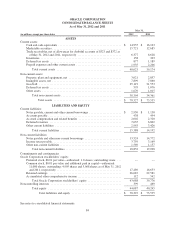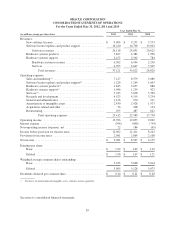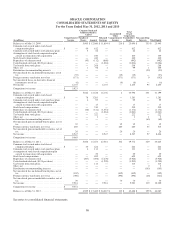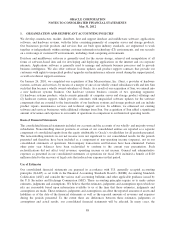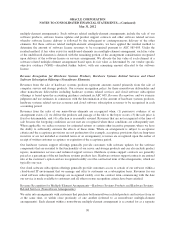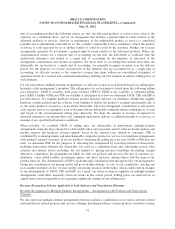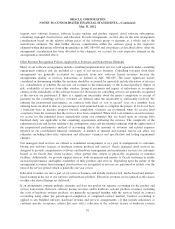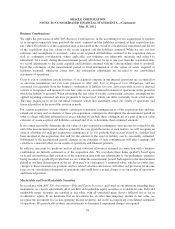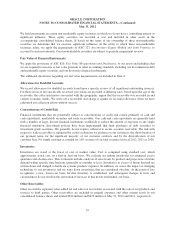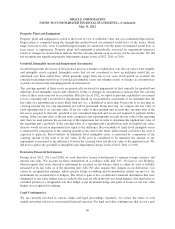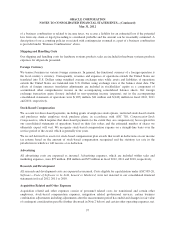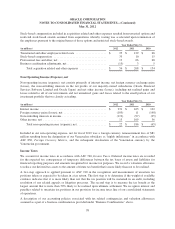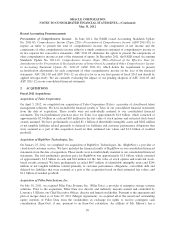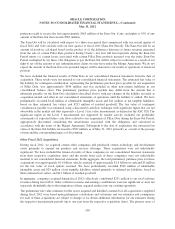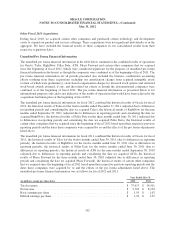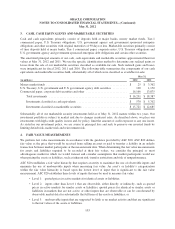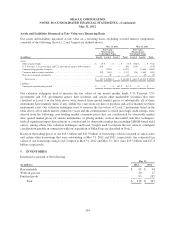Oracle 2012 Annual Report Download - page 98
Download and view the complete annual report
Please find page 98 of the 2012 Oracle annual report below. You can navigate through the pages in the report by either clicking on the pages listed below, or by using the keyword search tool below to find specific information within the annual report.ORACLE CORPORATION
NOTES TO CONSOLIDATED FINANCIAL STATEMENTS—(Continued)
May 31, 2012
Business Combinations
We apply the provisions of ASC 805, Business Combinations, in the accounting for our acquisitions. It requires
us to recognize separately from goodwill the assets acquired and the liabilities assumed, at their acquisition date
fair values. Goodwill as of the acquisition date is measured as the excess of consideration transferred and the net
of the acquisition date fair values of the assets acquired and the liabilities assumed. While we use our best
estimates and assumptions to accurately value assets acquired and liabilities assumed at the acquisition date as
well as contingent consideration, where applicable, our estimates are inherently uncertain and subject to
refinement. As a result, during the measurement period, which may be up to one year from the acquisition date,
we record adjustments to the assets acquired and liabilities assumed with the corresponding offset to goodwill.
Upon the conclusion of the measurement period or final determination of the values of assets acquired or
liabilities assumed, whichever comes first, any subsequent adjustments are recorded to our consolidated
statements of operations.
Costs to exit or restructure certain activities of an acquired company or our internal operations are accounted for
as one-time termination and exit costs pursuant to ASC 420, Exit or Disposal Cost Obligations, and are
accounted for separately from the business combination. A liability for costs associated with an exit or disposal
activity is recognized and measured at its fair value in our consolidated statement of operations in the period in
which the liability is incurred. When estimating the fair value of facility restructuring activities, assumptions are
applied regarding estimated sub-lease payments to be received, which can differ materially from actual results.
This may require us to revise our initial estimates which may materially affect our results of operations and
financial position in the period the revision is made.
For a given acquisition, we may identify certain pre-acquisition contingencies as of the acquisition date and may
extend our review and evaluation of these pre-acquisition contingencies throughout the measurement period in
order to obtain sufficient information to assess whether we include these contingencies as a part of the fair value
estimates of assets acquired and liabilities assumed and, if so, to determine their estimated amounts.
If we cannot reasonably determine the fair value of a pre-acquisition contingency (non-income tax related) by the
end of the measurement period, which is generally the case given the nature of such matters, we will recognize an
asset or a liability for such pre-acquisition contingency if: (i) it is probable that an asset existed or a liability had
been incurred at the acquisition date and (ii) the amount of the asset or liability can be reasonably estimated.
Subsequent to the measurement period, changes in our estimates of such contingencies will affect earnings and
could have a material effect on our results of operations and financial position.
In addition, uncertain tax positions and tax related valuation allowances assumed in connection with a business
combination are initially estimated as of the acquisition date. We reevaluate these items quarterly based upon
facts and circumstances that existed as of the acquisition date with any adjustments to our preliminary estimates
being recorded to goodwill provided that we are within the measurement period. Subsequent to the measurement
period or our final determination of the tax allowance’s or contingency’s estimated value, whichever comes first,
changes to these uncertain tax positions and tax related valuation allowances will affect our provision for income
taxes in our consolidated statement of operations and could have a material impact on our results of operations
and financial position.
Marketable and Non-Marketable Securities
In accordance with ASC 320, Investments—Debt and Equity Securities, and based on our intentions regarding these
instruments, we classify substantially all of our debt and marketable equity securities as available-for-sale. Debt and
marketable equity securities are reported at fair value, with all unrealized gains (losses) reflected net of tax in
stockholders’ equity. If we determine that an investment has an other than temporary decline in fair value, we
recognize the investment loss in non-operating income (expense), net in the accompanying consolidated statements
of operations. We periodically evaluate our investments to determine if impairment charges are required.
94


